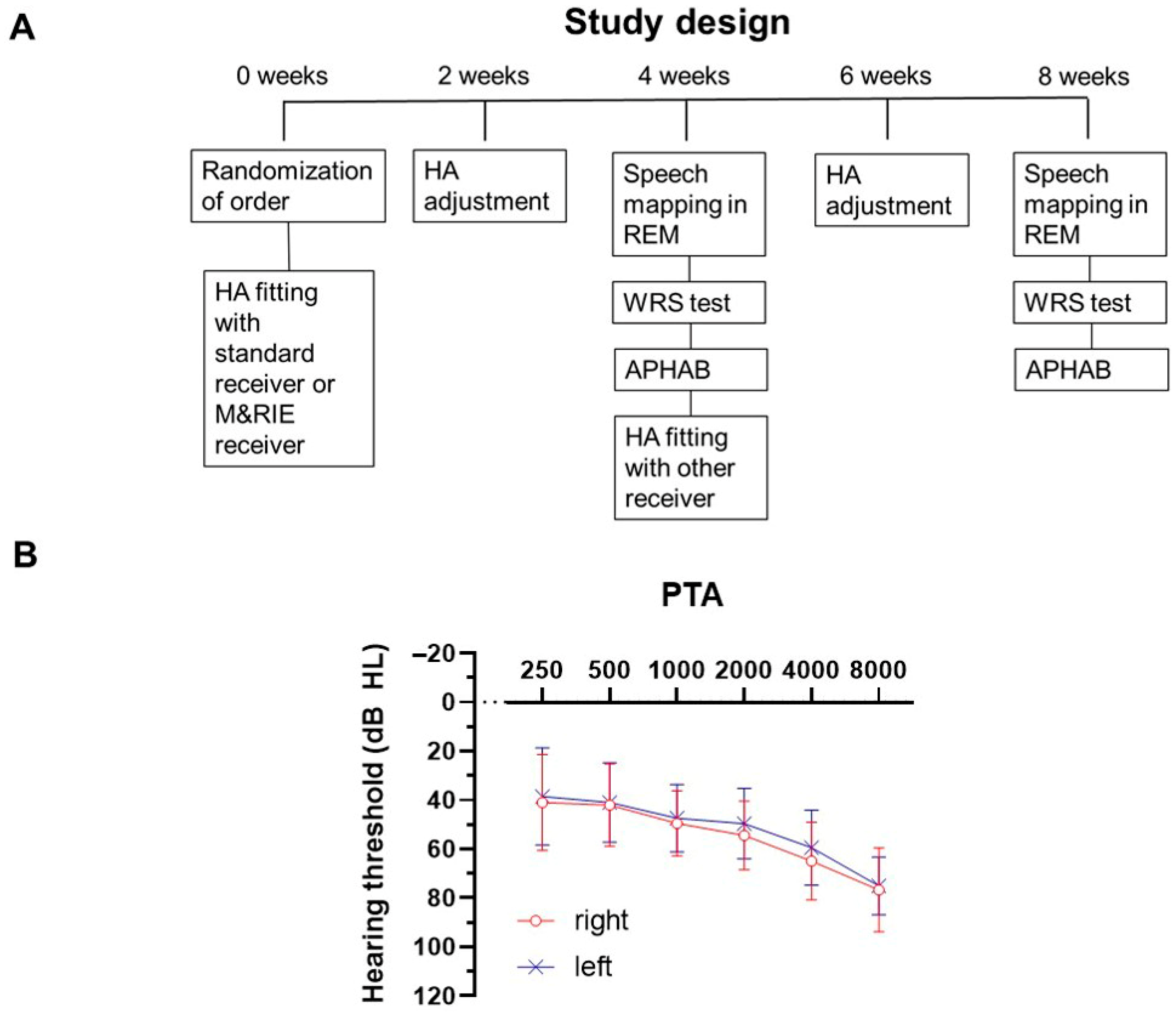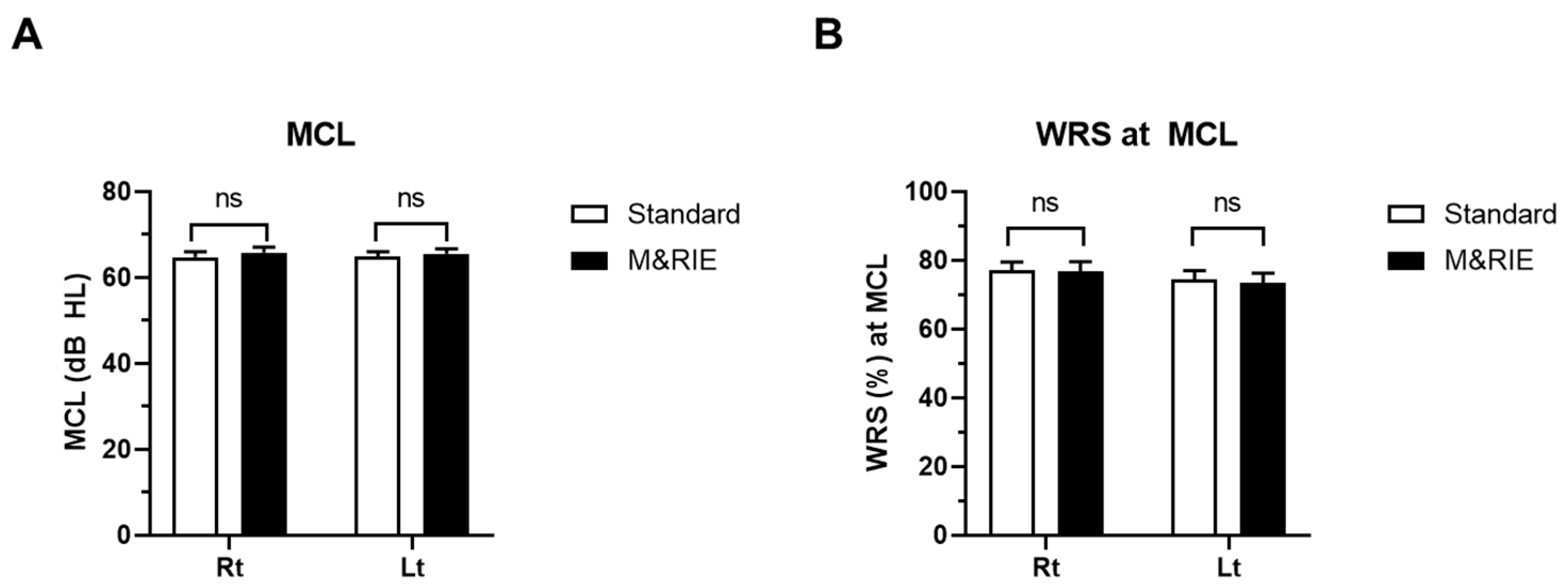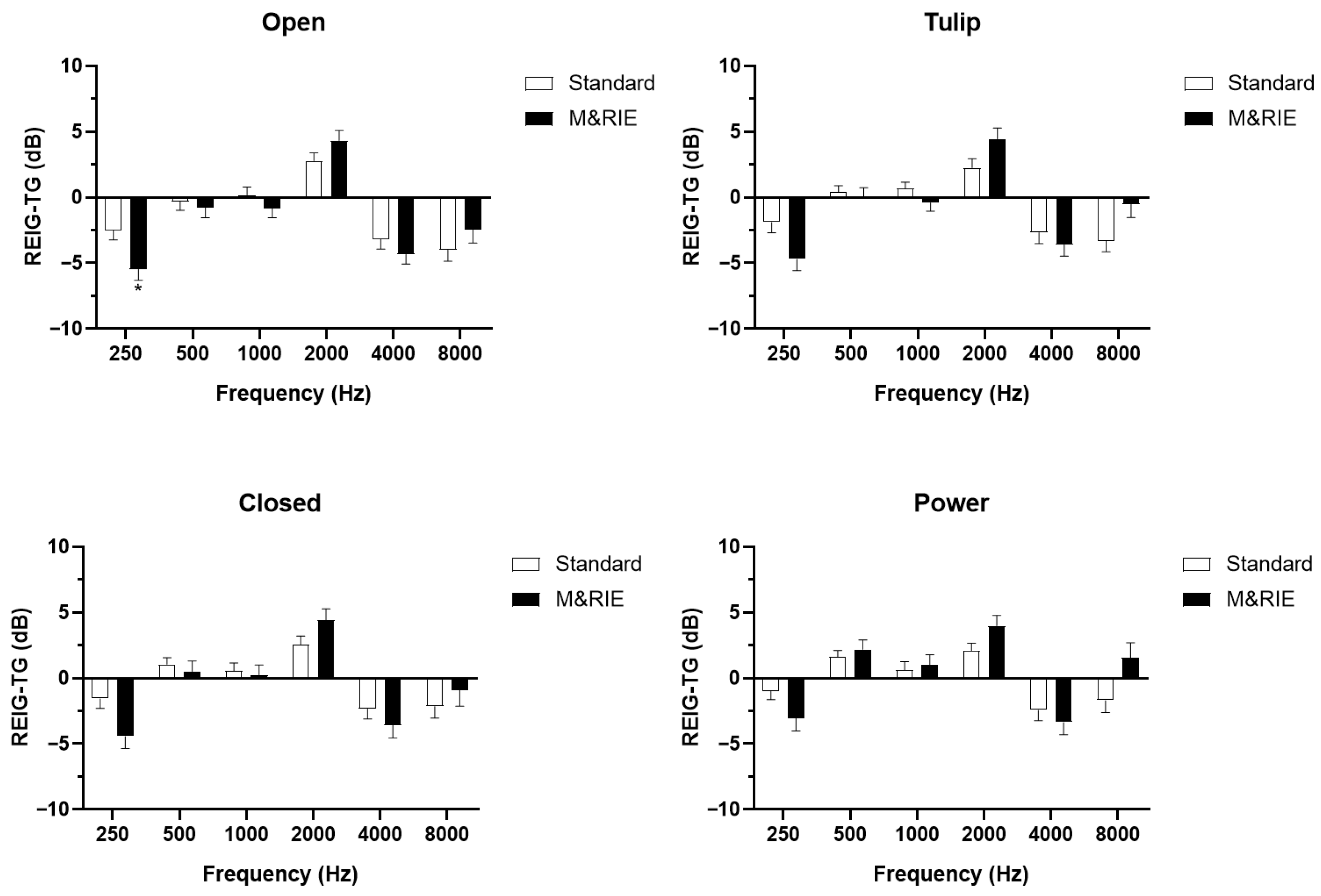The Effect of a Third In-Ear Microphone on User Satisfaction, Speech Intelligibility, and the Real-Ear Gain of Hearing Aids at a Conversational Level in Patients with Moderate Hearing Loss
Abstract
1. Introduction
2. Materials and Methods
2.1. Study Design
2.2. Randomization and Hearing Aid Fitting Protocol
2.3. Audiologic Assessment
2.4. Statistical Analysis
3. Results
3.1. Participant Demographics
3.2. Comparisons of APHAB Analysis
3.3. Comparisons of Speech Intelligibility
3.4. Comparisons of REIG Analysis
4. Discussion
Author Contributions
Funding
Institutional Review Board Statement
Informed Consent Statement
Data Availability Statement
Acknowledgments
Conflicts of Interest
References
- Kara, E.; Ozal, N.; Deniz, B.; Cogen, T.; Deniz, R.; Aydin, K.; Caba, C.; Yilmaz, B.B. Improving speech intelligibility in noise and spatial perception: The critical role of hearing aid microphone position. Front. Neurosci. 2024, 18, 1475122. [Google Scholar] [CrossRef]
- Picou, E.M.; Aspell, E.; Ricketts, T.A. Potential benefits and limitations of three types of directional processing in hearing aids. Ear Hear. 2014, 35, 339–352. [Google Scholar] [CrossRef]
- Pumford, J.M.; Seewald, R.C.; Scollie, S.D.; Jenstad, L.M. Speech recognition with in-the-ear and behind-the-ear dual-microphone hearing instruments. J. Am. Acad. Audiol. 2000, 11, 23–35. [Google Scholar] [CrossRef] [PubMed]
- Stone, M.A.; Lough, M.; Kuhnel, V.; Biggins, A.E.; Whiston, H.; Dillon, H. Perceived Sound Quality of Hearing Aids With Varying Placements of Microphone and Receiver. Am. J. Audiol. 2023, 32, 135–149. [Google Scholar] [CrossRef]
- Alworth, L.N.; Plyler, P.N.; Reber, M.B.; Johnstone, P.M. The effects of receiver placement on probe microphone, performance, and subjective measures with open canal hearing instruments. J. Am. Acad. Audiol. 2010, 21, 249–266. [Google Scholar] [CrossRef]
- Van den Bogaert, T.; Carette, E.; Wouters, J. Sound source localization using hearing aids with microphones placed behind-the-ear, in-the-canal, and in-the-pinna. Int. J. Audiol. 2011, 50, 164–176. [Google Scholar] [CrossRef]
- Carette, E.; Van den Bogaert, T.; Laureyns, M.; Wouters, J. Left-right and front-back spatial hearing with multiple directional microphone configurations in modern hearing aids. J. Am. Acad. Audiol. 2014, 25, 791–803. [Google Scholar] [CrossRef] [PubMed]
- Jones, H.G.; Kan, A.; Litovsky, R.Y. The Effect of Microphone Placement on Interaural Level Differences and Sound Localization Across the Horizontal Plane in Bilateral Cochlear Implant Users. Ear Hear. 2016, 37, e341–e345. [Google Scholar] [CrossRef] [PubMed]
- Boyd, A.W.; Whitmer, W.M.; Soraghan, J.J.; Akeroyd, M.A. Auditory externalization in hearing-impaired listeners: The effect of pinna cues and number of talkers. J. Acoust. Soc. Am. 2012, 131, EL268–EL274. [Google Scholar] [CrossRef]
- Durin, V.; Carlile, S.; Guillon, P.; Best, V.; Kalluri, S. Acoustic analysis of the directional information captured by five different hearing aid styles. J. Acoust. Soc. Am. 2014, 136, 818–828. [Google Scholar] [CrossRef]
- Byrne, D.; Noble, W. Optimizing sound localization with hearing AIDS. Trends Amplif. 1998, 3, 51–73. [Google Scholar] [CrossRef]
- Van Wanrooij, M.M.; Van Opstal, A.J. Relearning sound localization with a new ear. J. Neurosci. 2005, 25, 5413–5424. [Google Scholar] [CrossRef]
- Fortune, T.W. Real-ear polar patterns and aided directional sensitivity. J. Am. Acad. Audiol. 1997, 8, 119–131. [Google Scholar]
- Ricketts, T.; Lindley, G.; Henry, P. Impact of compression and hearing aid style on directional hearing aid benefit and performance. Ear Hear. 2001, 22, 348–361. [Google Scholar] [CrossRef]
- Best, V.; Roverud, E. Externalization of speech when listening with hearing aids. Trends Hear. 2024, 28, 23312165241229572. [Google Scholar] [CrossRef]
- Groth, J. An innovative RIE with microphone in the ear lets users “hear with their own ears”. ReSound Whitepaper 2020, 7, 5. [Google Scholar]
- Chaithra, M.C.; Manjula, P. Speech perception outcomes in hearing-impaired individuals with microphone & receiver in the ear (M&RIE) hearing aids. Eur. Arch. Otorhinolaryngol. 2024, 281, 3813–3820. [Google Scholar] [CrossRef] [PubMed]
- Korhonen, P. Wind Noise Management in Hearing Aids. Semin. Hear. 2021, 42, 248–259. [Google Scholar] [CrossRef] [PubMed]
- Koh, Y.I.; Oh, K.S.; Kim, J.A.; Noh, B.; Choi, H.J.; Joo, S.Y.; Rim, J.H.; Kim, H.-Y.; Kim, D.Y.; Yu, S. OSBPL2 mutations impair autophagy and lead to hearing loss, potentially remedied by rapamycin. Autophagy 2022, 18, 2593–2614. [Google Scholar] [CrossRef]
- Na, G.; Kwak, S.H.; Jang, S.H.; Noh, H.E.; Kim, J.; Yang, S.; Jung, J. Supplementary effect of choline alfoscerate on speech recognition in patients with age-related hearing loss: A prospective study in 34 patients (57 ears). Front. Aging Neurosci. 2021, 13, 684519. [Google Scholar]
- Rim, J.H.; Noh, B.; Koh, Y.I.; Joo, S.Y.; Oh, K.S.; Kim, K.; Kim, J.A.; Kim, D.H.; Kim, H.-Y.; Yoo, J.E. Differential genetic diagnoses of adult post-lingual hearing loss according to the audiogram pattern and novel candidate gene evaluation. Hum. Genet. 2022, 141, 915–927. [Google Scholar] [CrossRef]
- Bae, S.H.; Joo, S.Y.; Jang, S.H.; Kim, S.H.; Choi, J.Y.; Won, D.; Gee, H.Y.; Jung, J. The audiological phenotype of patients with a variant in MYH9 and MYH14 genes. Sci. Rep. 2025, 15, 22324. [Google Scholar] [CrossRef]
- Choi, S.J.; Park, B.; Lee, S.-U.; Chang, J.; Im, G.J.; Park, E. Can a Narrow Frequency Allocation Improve Speech Perception in Korean Cochlear Implant Users? J. Audiol. Otol. 2025, 29, 226. [Google Scholar] [CrossRef]
- Lee, H.-J.; Lee, J.M.; Choi, J.Y.; Jung, J. Evaluation of maximal speech intelligibility with vibrant soundbridge in patients with sensorineural hearing loss. Otol. Neurotol. 2017, 38, 1246–1250. [Google Scholar] [CrossRef] [PubMed]
- Cox, R.M.; Risberg, D.M. Comparison of in-the-ear and over-the-ear hearing aid fittings. J. Speech Hear. Disord. 1986, 51, 362–369. [Google Scholar] [CrossRef] [PubMed]
- Denk, F.; Ewert, S.D.; Kollmeier, B. Spectral directional cues captured by hearing device microphones in individual human ears. J. Acoust. Soc. Am. 2018, 144, 2072. [Google Scholar] [CrossRef] [PubMed]




| Characteristics | Value (%) |
|---|---|
| Age (yr) | 72.4 ± 12.7 years |
| Sex | |
| Male | 20 (51.3) |
| Female | 19 (48.7) |
| First receiver | |
| Standard receiver | 15 (38.5) |
| M&RIE receiver | 24 (61.5) |
| Side of Hearing aid | |
| Bilateral | 30 (76.9) |
| Unilateral | 9 (23.1) |
| Hearing level (PTA4) | |
| Right | 52.4 ± 11.1 dB HL |
| Left | 48.9 ± 11.2 dB HL |
| Word recognition score at MCL | |
| Right | 77.2 ± 13.8% |
| Left | 74.4 ± 16.1% |
| Configuration | |
| Ski-slope type | 30 ears (43.0) |
| Flat type | 39 ears (57.0) |
| Receiver Preference | |
| Standard receiver | 23 (59.0) |
| M&RIE receiver | 16 (41.0) |
Disclaimer/Publisher’s Note: The statements, opinions and data contained in all publications are solely those of the individual author(s) and contributor(s) and not of MDPI and/or the editor(s). MDPI and/or the editor(s) disclaim responsibility for any injury to people or property resulting from any ideas, methods, instructions or products referred to in the content. |
© 2025 by the authors. Licensee MDPI, Basel, Switzerland. This article is an open access article distributed under the terms and conditions of the Creative Commons Attribution (CC BY) license (https://creativecommons.org/licenses/by/4.0/).
Share and Cite
Kwak, S.H.; Cheon, D.; Bae, S.H.; Kim, D.; Jung, J. The Effect of a Third In-Ear Microphone on User Satisfaction, Speech Intelligibility, and the Real-Ear Gain of Hearing Aids at a Conversational Level in Patients with Moderate Hearing Loss. J. Clin. Med. 2025, 14, 6791. https://doi.org/10.3390/jcm14196791
Kwak SH, Cheon D, Bae SH, Kim D, Jung J. The Effect of a Third In-Ear Microphone on User Satisfaction, Speech Intelligibility, and the Real-Ear Gain of Hearing Aids at a Conversational Level in Patients with Moderate Hearing Loss. Journal of Clinical Medicine. 2025; 14(19):6791. https://doi.org/10.3390/jcm14196791
Chicago/Turabian StyleKwak, Sang Hyun, Dongchul Cheon, Seong Hoon Bae, Daeyoung Kim, and Jinsei Jung. 2025. "The Effect of a Third In-Ear Microphone on User Satisfaction, Speech Intelligibility, and the Real-Ear Gain of Hearing Aids at a Conversational Level in Patients with Moderate Hearing Loss" Journal of Clinical Medicine 14, no. 19: 6791. https://doi.org/10.3390/jcm14196791
APA StyleKwak, S. H., Cheon, D., Bae, S. H., Kim, D., & Jung, J. (2025). The Effect of a Third In-Ear Microphone on User Satisfaction, Speech Intelligibility, and the Real-Ear Gain of Hearing Aids at a Conversational Level in Patients with Moderate Hearing Loss. Journal of Clinical Medicine, 14(19), 6791. https://doi.org/10.3390/jcm14196791





